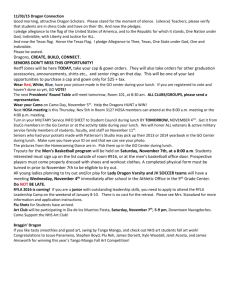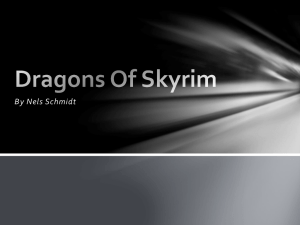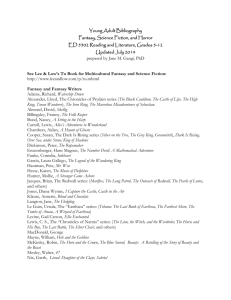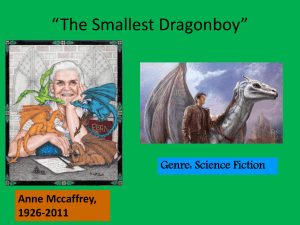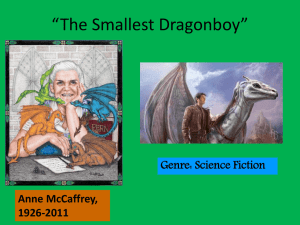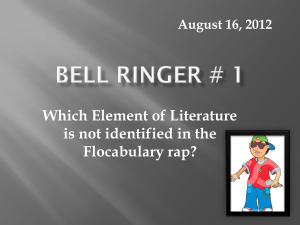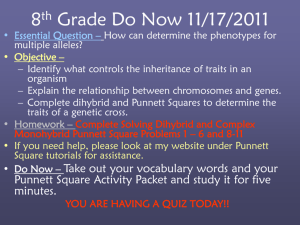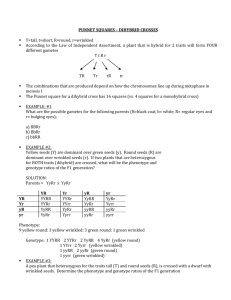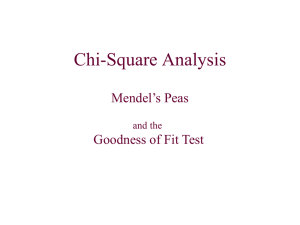Test 1, 2013
advertisement
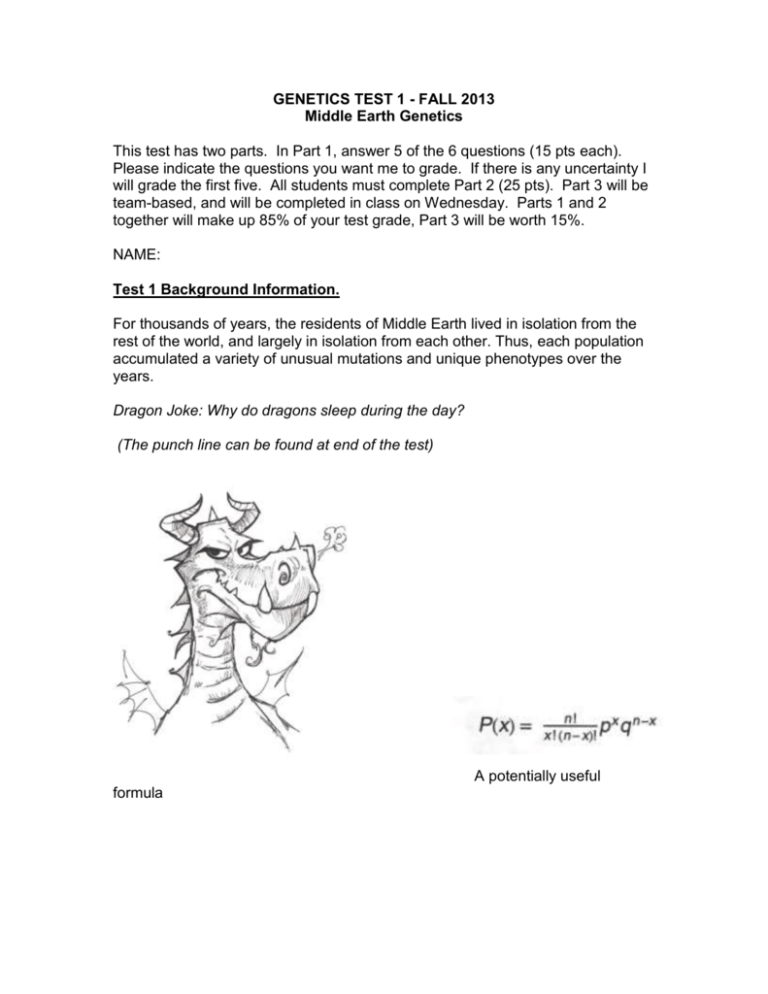
GENETICS TEST 1 - FALL 2013 Middle Earth Genetics This test has two parts. In Part 1, answer 5 of the 6 questions (15 pts each). Please indicate the questions you want me to grade. If there is any uncertainty I will grade the first five. All students must complete Part 2 (25 pts). Part 3 will be team-based, and will be completed in class on Wednesday. Parts 1 and 2 together will make up 85% of your test grade, Part 3 will be worth 15%. NAME: Test 1 Background Information. For thousands of years, the residents of Middle Earth lived in isolation from the rest of the world, and largely in isolation from each other. Thus, each population accumulated a variety of unusual mutations and unique phenotypes over the years. Dragon Joke: Why do dragons sleep during the day? (The punch line can be found at end of the test) A potentially useful formula Part One. Complete 5 of the following 6 questions. Please show all work and indicate which questions you want me to grade. Question One: In Hobbits, Hairy feet (H) are dominant to hairless feet (f) and Bristly toe hair (B) is dominant to soft toe hair (b). Based on the results of the crosses below, determine the genotypes of all of the individuals, and write them below their phenotypes: Parental Phenotype: Offspring Phenotypes: a) Hairy, Bristly x Hairy, Soft ½ Hairy, Bristly; ½ Hairy, Soft b) Hairy, Soft x Hairy, Soft ¾ Hairy, Soft; ¼ Hairless, Soft Question Two: In Dragons, two genes, Y and R, affect scale color. Neither is completely dominant, and the two interact with each other to produce seven different scale colors: YYRR = Crimson YyRR = Magenta YYRr = orange-red YyRr = magenta-rose YYrr = yellow Yyrr = pale yellow yyRR, yyRr and yyrr = white a) If you cross a crimson (YYRR) dragon with a white dragon (yyrr), what will be the genotype and phenotype of the F1 progeny (2 points)? b) If you cross the F1 dragons from (a), what proportion of the progeny will be expected to be crimson (4 points)? c) If you cross the F1 dragons from (a), what proportion of the progeny will be expected to be pale yellow (4 points)? d) If the dragons in part (a) have two clutches (litters) of progeny, what is the probability that they will consist of two crimson and one pale yellow dragon (in any order) in the first clutch, and 4 crimson dragons in the second clutch (5 points)? Question Three: In dwarves from Middle Earth, Brown beards (B) are dominant to black beards (b). In addition, preference for warhelms in these dwarves seems to be determined by a single, sex-influenced gene. The desire to wear horned helms (H) is dominant to the desire to wear hornless helms (h) in males, but it is recessive in females. A horned-helm, black-bearded male dwarf married a hornless helm, brownbearded female dwarf (yes, all dwarf women do have beards!) and produced the following offspring: Of the males, ¼ preferred horned helms and had brown beards; ¼ are preferred horned helms and had black beards; ¼ preferred hornless helms and had brown beards; and ¼ preferred hornless helms and had black beards. Of the females, ½ preferred hornless helms and had black beards, and ½ preferred hornless helms and had brown beards. What are the genotypes of the parent dwarves? Please show your work/explain your reasoning….don’t just state genotypes. Question Four: Members of an entirely different tribe of dwarves from far away “Disneyland” often, to the disgust of their Middle Earth relatives, lacks warhelms entirely, preferring floppy caps. They also have many other unique phenotypes. A three-generation pedigree for a fairly common trait in this group of dwarves is red noses, and is shown in the figure below: a) What is the most likely mechanism of inheritance for the trait? Clearly state your reasoning (5 points). Include in your reasoning how you have distinguished between dominant versus recessive inheritance as well as between autosomal versus sex-linked inheritance. b) What is the probability that III-2 is heterozygous (4 points)? c) If III-3 and III-4 marry, what is the probability that their first child will have the trait (4 points)? Question Five: Hobbits are often fanatical about their pipe-smoking tobacco, going to great lengths to raise unique strains, so a hobbit horticulturalist was quite excited to have developed two true-breeding strains of smoking tobacco, one that produced white smoke, and one that produced red smoke. When he crossed these two strains, all of the progeny produced white smoke. When these F1 progeny were intercrossed, the F2 progeny were in the following ratios: 12 white smoke: 3 red smoke: 1 yellow smoke. Propose a genetic hypothesis to account for these results, clearly showing the genotypes of each phenotypic class of plants in all generations. Question Six: In humans, males are the heterogametic sex (XY), while many birds are just the opposite. Not surprisingly, the heterogametic sex of dragons is unknown (yeah, you try draw blood to karyotype a dragon...). You do know, however, that the dominant trait for Long wings (L) versus wingless (l) is on the X chromosome of dragons. Fortunately, you can, from a safe distance, observe the results of dragon matings in order to satisfy your curiosity in this regard. Contrast the expected phenotypic ratios of the F1 generation from a cross between a female that is true-breeding for long wings and a male that is true-breeding for wingless when (a) the female is the heterogametic sex and (b) the male is the heterogametic sex. Part Two: All students must answer this question. The pedigree below shows the inheritance of an extremely rare and embarrassing genetic condition in dragons – called “vegetarianism”. 1) Propose the most likely mode of inheritance for vegetarianism, stating clearly what your rationale is for your decision. 2) Given that mode of inheritance, and using appropriate gene symbols, draw the how the chromosomes of dragons II-4 and III-3 would look during metaphase of meiosis I. Be sure to show all sister chromatids, and to label the alleles present on each sister chromatid. 3) What is the probability that the next three dragon offspring that II-4 and II-5 have will be affected, then unaffected, then affected? Dragon riddle answer: Because they prefer to fight knights! Mitosis and Meiosis Follow-Up Question. This question is worth up to 15 points, and all points that you earn will be added directly to your score for I-RAP #2. Your score on this question will not impact your score on this unit test in any way. I will also average the scores for you and all of your team members on this question, and will add those points directly to your T-RAP for that week, so the better you do, the better it will be for your team. Good luck! A magenta (YyRR) dragon is crossed with a white (yyRr) dragon, producing a white fledgeling. Using the color key from question two to guide you, draw the chromosomes of each of the dragons below at the metaphase stage indicated. Assume that crossing over does NOT occur in dragons. Make sure to show alleles on both sister chromatids, and to label sister chromatids and homologs, when possible. If there is more than one possibility, you need only draw one. Magenta parent: Metaphase of Meiosis II White parent: Metaphase of Mitosis White fledgeling: Metaphase of Meiosis I

